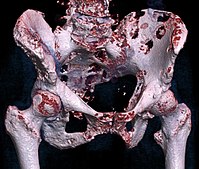
Photo from wikipedia
Simple Summary KRAS G12C mutations are important oncogenic mutations in lung cancer that can now be targeted by allosteric small molecule inhibitors. We assessed the imaging features and patterns of… Click to show full abstract
Simple Summary KRAS G12C mutations are important oncogenic mutations in lung cancer that can now be targeted by allosteric small molecule inhibitors. We assessed the imaging features and patterns of metastases in these lung cancers compared to other mutated lung cancers. We found that KRAS G12C NSCLC has distinct primary tumor imaging features and patterns of metastasis when compared to those of NSCLC driven by other genetic alterations. These distinct imaging features may offer clues to its presence and potentially guide management in the future. Abstract KRAS G12C mutations are important oncogenic mutations that confer sensitivity to direct G12C inhibitors. We retrospectively identified patients with KRAS+ NSCLC from 2015 to 2019 and assessed the imaging features of the primary tumor and the distribution of metastases of G12C NSCLC compared to those of non-G12C KRAS NSCLC and NSCLC driven by oncogenic fusion events (RET, ALK, ROS1) and EGFR mutations at the time of initial diagnosis. Two hundred fifteen patients with KRAS+ NSCLC (G12C: 83; non-G12C: 132) were included. On single variate analysis, the G12C group was more likely than the non-G12C KRAS group to have cavitation (13% vs. 5%, p = 0.04) and lung metastasis (38% vs. 21%; p = 0.043). Compared to the fusion rearrangement group, the G12C group had a lower frequency of pleural metastasis (21% vs. 41%, p = 0.01) and lymphangitic carcinomatosis (4% vs. 39%, p = 0.0001) and a higher frequency of brain metastasis (42% vs. 22%, p = 0.005). Compared to the EGFR+ group, the G12C group had a lower frequency of lung metastasis (38% vs. 67%, p = 0.0008) and a higher frequency of distant nodal metastasis (10% vs. 2%, p = 0.02). KRAS G12C NSCLC may have distinct primary tumor imaging features and patterns of metastasis when compared to those of NSCLC driven by other genetic alterations.
Journal Title: Cancers
Year Published: 2021
Link to full text (if available)
Share on Social Media: Sign Up to like & get
recommendations!